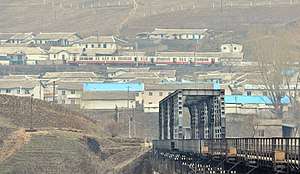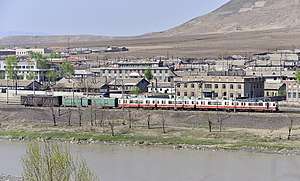BVG Class G
Class G are a type of electric multiple unit trains used on the Berlin U-Bahn.

.jpg)
While in West Berlin newer and newer vehicles were built and used, in East Berlin the pre-war A-I and A-II trains were still running. Only the Line E (currently U5) had trains converted from the former Berlin S-Bahn vehicles. The problem with the procurement of the vehicles is that they need a modified design for the smaller profile vehicle, as it has to differentiate the normal shoes, that is why transport companies were reluctant to commission them. In 1974, the LEW "Hans Beimler" had commissioned four prototypes of the new G double multiple unit, called Gustav in popular parlance.
As before, the seats were located alongside the train walls. The top speed was 70 km/h. The smallest unit of these trains were half trains made up of two double multiple units. After intensive testing the LEW Hennigsdorf factory began manufacturing the trains. The production models had lower side windows and a changed front, but were technically the same. 114 cars were built until 1982. There were 24 more, but those were delivered to Greece for a railway line there. They were returned to Berlin in 1984/85.
In 1987 a new batch of GI-trains was delivered, but with technical changes that made coupling them with the older cars impossible. Because of these changes the new trains were called GI/1. Their popular nickname was Gisela. A speciality of these cars was the fact that they had only two doors per side, unlike the other Kleinprofil trains, which had three. Before the fall of the Berlin Wall, the last trains were delivered on October 1989. It replaced all the BVG Class A trains by 5 November 1989.
Most of the trains were deployed to the former eastern part of U2, before reusing it on U1 (Schlesches Tor - Ruhleben) for the increasing night service in December 1990, before deploying it on U12 and U15 after the U2 was reconnected in 1993. As of today, this trains are deployed on U1 and U2. Those trains are not deployed on U3 and U4 unless it is for emergency use. Trains were renumbered to use 2xx - 4xx numbers in 1992.
All the older G stock were sold to Pyongyang (GI), the G cars went for scrap in 1997, and all the GI/1 trains were refurbished into GI/1E from 2005 to 2007 in order to extend its lifespan.
Fleet information
| Type | Class Year | Athens | BVB | BVG |
|---|---|---|---|---|
| G | 1974 | 135 750–135 756 135 751–135 757 | 499–493 498–492 | |
| GI | 1978 | 135 758–135 772 135 759–135 773 | 491–477 490–476 | |
| 1979 | 135 774–135 778 135 775–135 779 | 475–471 474–470 | ||
| 1979 | 135 782–135 794 135 783–135 795 | 469–457 468–456 | ||
| 1980 | 135 796–135 832 135 797–135 833 | 455–419 454–418 | ||
| 1980 | 135 836 135 837 | 417 416 | ||
| 1981 | 135 838–135 852 135 839–135 853 | 415–401 414–400 | ||
| 1982 | 135 854–135 856 135 855–135 857 | 399–397 398–396 | ||
| 1983 | 135 858–135 862 135 859–135 863 | 395–391 394–390 | ||
| GII | 1983 | 102 202 | 135 866 135 867 | 389 388 |
| 1983 | 104–107 204–207 | 135 870–135 876 135 871–135 877 | 387–381 386–380 | |
| 1983 | 108 201 | 135 878 135 879 | 379 378 | |
| 1983 | 109–112 209–212 | 135 880–135 886 135 881–135 887 | 377–371 376–370 | |
| GI/1 | 1987 | 135 896–135 898 135 897–135 899 | 369–367 368–366 | |
| 1988 | 135 900–135 938 135 901–135 939 | 365–327 364–326 | ||
| 1989 | 135 940–135 998 135 941–135 999 | 325–267 324–266 |
Korean State Railway 500 series

After the GI class were withdrawn from use on the Pyongyang Metro, they were converted by the Kim Chong-t'ae Electric Locomotive Works to operate as EMUs on the national railway lines of the Korean State Railway, which numbered them in the 500 series. They are frequently seen in the northern part of North Korea, running along the Hambuk Line, the Pukpu Line and the Manpo Line; they are occasionally seen running as mixed trains pulling regular railway freight cars.